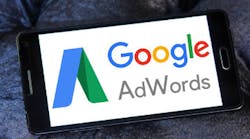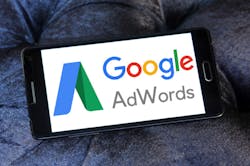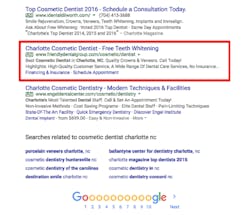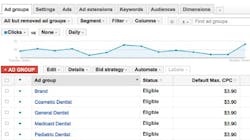More new patients and brand awareness for your dental practice with Google Ads
ALL DENTAL PRACTICES need a steady flow of new patients to sustain their businesses and experience positive ROI. This simply means getting new clients in the door from all age groups, be they Millennials, Generation X-ers, or Baby Boomers. Dentists can use Google AdWords as an internet marketing strategy to reach each of these demographics in their target markets. Here's how!
With paid search, dentists can attract new patients with discounted offers, allow existing patients to easily schedule appointments, and so much more. When you advertise with Google AdWords, your ads will be visible only to people who search the keywords and phrases that are specifically chosen for your campaign. There are many benefits to Google AdWords, such as flexibility, targeted users, and traffic generation. These benefits will vary from one practice to another: if you are just starting out, then your paid search needs will be different from dentists who have been in business much longer. To understand the benefit of Google AdWords, let's break down the different approaches and benefits for new versus established dentists.
For the dentist with a new practice
A new dental practice needs visibility. Why? Because a new website requires time before it shows up in local search results. New websites don’t have the history, trust, and online marketing attributes that Google uses to rank it high in search results for targeted keywords. If your competitors have been effectively using search engine optimization strategies for years, you won’t outperform their efforts immediately. Using Google AdWords helps give your practice a nudge to the top of search results so it's visible to customers who are looking for your targeted treatments. These types of marketing campaigns should have an end goal, which is to appear in organic search listings.
To use an example: It's obvious that people see Google Ads. We have for our South Park dentist client as an actual ad in Google search results. However, the goal is not to "trick" users into not seeing the word “Ad” right beside it. The goal is constant brand awareness.
Above: Google Ad for one of our clients. The goal is to establish brand awareness.
An additional goal is to show up at the top of search results as a Google Ad in organic searches and Google's "3-pack" local listings. Again, this ensures users consistently see your brand.
Another strategy is this: You can effectively execute retargeting in Google AdWords. This will allow you to "follow" people around the web. This sounds sneaky, I know! But this is a legit online-marketing strategy that allows local businesses to keep their brands in front of the right customers by through Google Ads.
Once a new practice has implemented these strategies, it's time to move onto strategies for existing practices.
For the dentist with an established practice
Even though dental practices can experience great success with Google AdWords, dentists must deal with some highly competitive keywords that can make it hard to move ahead of the competition. As well as making other efforts to improve your rankings (e.g., SEO and blogging), AdWords is a viable option for better search visibility.
Here are the three benefits that practices will see with continued use of Google AdWords:
Attracting new patients from your local area—Getting new patients from local search listings can be great for a dental practice when using Google AdWords. Even though Google allows you to expand the geographical reach of your dental practice, being listed in the local search results can help drive targeted traffic directly to your practice. You can design your campaign to target new patients within a three- to five-mile radius of your location.
Target specific patient needs—You can put your practice in front of new patients who are looking for specific services, such as emergency dental care, pediatric dentistry, teeth whitening, and dental implants. This provides a greater opportunity than merely targeting general keywords like "local dentist in . . . "
Here is an example a paid search campaign for one of our dental clients that demonstrates how we are targeting different treatment options for those specific searches online.
Above: Google Ad Groups
As you can see above, we created Google Ad Groups specifically for the dental practice’s brand, as well as cosmetic, general, and pediatric treatment services.
You can control new-patient flow—Once your Google AdWords campaign is performing well, you can effortlessly switch it on or off, depending on your needs. No other marketing solution will give you the flexibility to speed up or slow down referrals.
Getting started
Google AdWords looks complicated, but it's easy to set up if you learn the process. Google AdWords has helped many dentists across the world generate highly targeted traffic.
Improving your current campaign
If you are using Google AdWords already, are you wondering why others are doing so well and you're not? Well, the ads are an invaluable tool for dentists, but there are some strategies you can use to bring down cost and increase conversions.
Improve your quality score—Improving your quality score can help you keep costs down. One way to do this is by ensuring you have at least three ads per ad group. Make the three ads test variations against each other. For example, you can make the ads all have the same description but have different ad titles. That way you can see which one is served more based on clicks, customer engagement, and other Google AdWords metrics. Analyze the data and go with the high-performing ad for a while.
If test ads are not performing well, pause them or figure out ways to improve them. You want to switch off the ads with lower click-through rates (CTR) and conversions. Create new ones and continue to test. The new ads should be a better version of the high-performing ads. This strategy will mean that you’ll continually improve your CTR and subsequently your quality score.
In addition, create Google Ad Groups specifically for certain keywords and make your ad copies reflect those specific keywords. This will help improve quality score. For example, you should have one ad group for "pediatric" targeted keywords. The ad copy for the pediatric ad group should only discuss pediatric-related keywords and not other dental treatment options.
Use specialty keywords—I mentioned this above, but you should divide your keywords into niche groups and create ads for each one. This will increase the relevance of your prospects and your CTR. The keywords you choose should be what prospects are typing in to Google when looking for your products and services. Combine them with phrases that pertain to your local area to target patients who will quickly become paying customers.
Pay attention to your ad copy—Even after choosing the best keywords and creating what you think is compelling sales copy, your Google AdWords campaign may fail. To effectively reach potential customers, you should aim to create specific, relevant, attractive, and empowering copy. Here is one example:
Above: Create effective ad copy
The ad copy needs to be compelling and relevant to customers' search queries.See how the ads above are relevant to the search query? To enhance your ad, don’t forget to add Ad Extensions to attract users to click.
Competition Research—Finally, one strategy that can help you stay ahead is competitive analysis. This is the most important thing you need to do before starting the new campaign. Analyzing your competitors' ad campaigns is an excellent way of extracting data about their historical performance. It will also help you examine your own ads to see what’s missing. You can use tools like spyfu.com, semrush.com, and so on. These are some of the marketing tools that we use to spy on our dental clients' competitors to ultimately outperform their marketing campaigns.
Conclusion
Getting visibility or targeted traffic for a dental practice can be tough because you are trying to reach a unique audience. This is where Google AdWords can help you right off the bat. With AdWords, you can get immediate visibility in Google local search as a local dental practice. Successful dentists use paid search to get their practices to the top of search results and generate more leads, while SEO campaigns for dentists can have a much slower impact. I recommend using Google AdWords if you have the budget, as it will give your dental practice a leg up on your competition—no matter if you are new or a more established practice.
Author's note: If you want to improve your dental practice by attracting more patients online and improving your online marketing, we’re here to help! Don’t hesitate to reach out to Organic Clicks, LLC for a free initial assessment.
ALSO BY LAMAR HULL:3-point checklist to make sure your dental website is mobile-index ready
Editor's note: This article first appeared in the Apex360 e-newsletter. Apex360 is a DentistryIQ partner publication for dental practitioners and members of the dental industry. Its goal is to provide timely dental information and present it in meaningful context, empowering those in the dental space to make better business decisions.
Subscribe to the Apex360 e-newsletter here.
Dental news and press releases may be sent to Apex360 editors at [email protected]">[email protected].
For the most current dental headlines, click here.
About the Author

Lamar Hull
Founder, Organic Clicks LLC
Lamar Hull is the Founder of Organic Clicks, LLC a local SEO Company based out of Charlotte, North Carolina. Organic Clicks LLC specializes in local SEO, website design, paid search, and social media marketing for health-care practices such as dental offices. Don’t hesitate to reach out to Organic Clicks, LLC for an initial assessment.
Updated December 21, 2017






